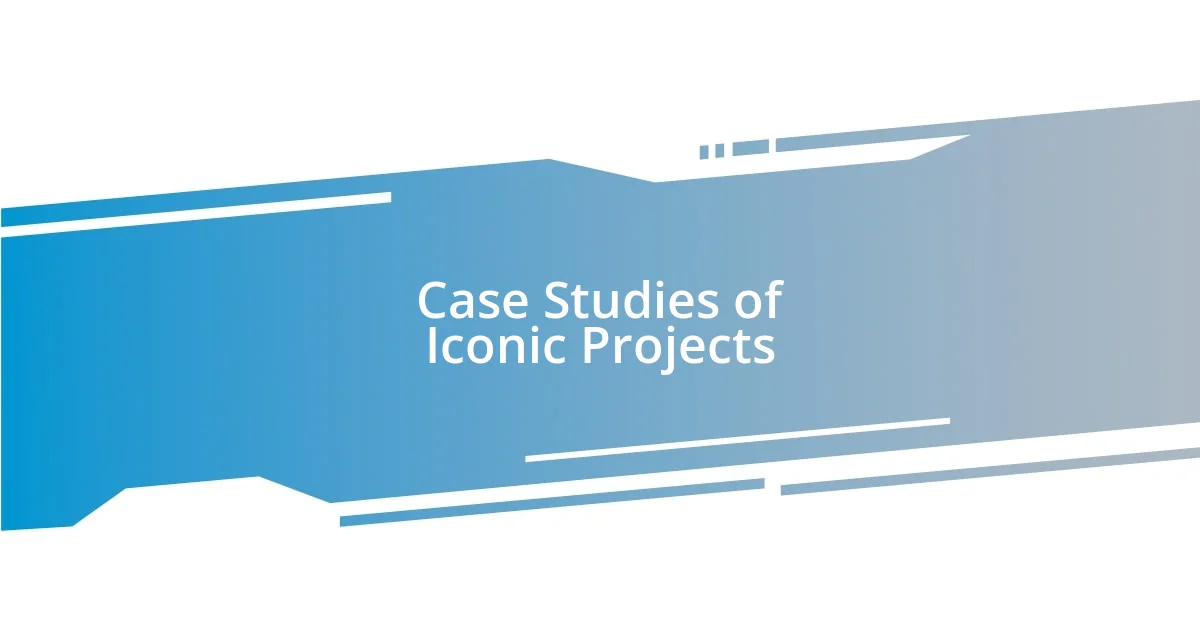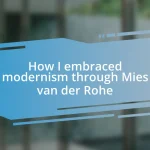Key takeaways:
- Gehry’s architecture elicits strong emotional responses through unconventional forms, transforming how we interact with and perceive spaces.
- His designs, influenced by diverse cultural experiences and artistic collaborations, challenge traditional architectural norms, emphasizing fluidity, materiality, and engagement with the environment.
- Structures like the Guggenheim Museum and the Walt Disney Concert Hall embody dynamic narratives that encourage viewers to explore their complexities and embrace the interplay between the built environment and human experience.

Introduction to Gehry’s Architecture
When I first encountered Frank Gehry’s architecture, I was captivated by its sculptural quality and daring forms. His designs often challenge conventional notions of what a building should look like, prompting me to ask: can architecture be truly expressive? The irregular shapes and unexpected materials seem to dance across the landscape, transforming the environment.
Walking into one of Gehry’s creations, I felt an immediate emotional response; his random curves and jagged angles invite you to explore, to navigate spaces that feel both familiar and utterly new. It reminds me of an abstract painting—each glance reveals a different perspective. His architecture isn’t merely functional; it evokes feelings and sparks curiosity about how we interact with our spaces.
Gehry’s work pushes boundaries, making us reconsider the relationship between form and function. It’s this innovative spirit that inspires me as I explore his designs further. How does the playfulness of his architecture reflect the human experience? I believe it captures the joy of creativity, urging us to embrace chaos in a structured world.

Understanding Unconventional Forms
Understanding unconventional forms in architecture can be a transformative experience. When I first stood in front of the Guggenheim Museum in Bilbao, I realized how Gehry’s unconventional approach defies traditional architectural expectations. The building’s fluid shapes created an impression of movement, almost as if it were alive. It made me reflect on how structures can embody emotion and narrative, rather than just serve a purpose.
To truly appreciate these unconventional forms, it’s helpful to consider a few key elements:
- Fluidity: The way lines flow and bend creates a sense of dynamism, inviting exploration.
- Materials: Gehry often uses unexpected materials, like titanium and glass, pushing boundaries and enhancing visual interest.
- Interaction: The irregular shapes engage the viewer, encouraging different perspectives and experiences with each visit.
- Context: Unconventional forms respond to their environment, shaping and reshaping the surrounding space in meaningful ways.
These characteristics prompt us to rethink how we connect to architecture. My visit to the Walt Disney Concert Hall was eye-opening; the sunlight cast reflections that shifted throughout the day, revealing new facets of the building. This continuous change mirrors life itself, reminding me that architecture can indeed resonate with our human experience.

Influences Behind Gehry’s Designs
Gehry’s designs are undeniably influenced by a multitude of sources that resonate deeply with my own experiences. His childhood in Toronto, characterized by a vibrant mix of cultures, undoubtedly shaped his perception of form and space. I remember visiting Toronto’s Distillery District and seeing how diverse architectural styles could coexist, creating a bustling atmosphere that felt electric. Similarly, Gehry’s works evoke this sense of lived experience, inspiring feelings of relatability and connection in the viewer.
Moreover, his fascination with the deconstructivism movement plays a crucial role in shaping his unconventional forms. I find this approach fascinating, as it breaks down traditional architectural norms, challenging us to look beyond mere aesthetics. The way shadows play across the surfaces of the buildings reminds me of how the sun casts intricate patterns in nature. Gehry’s work encourages us to find beauty in what is typically overlooked and to consider the complexities of our surroundings.
Lastly, Gehry’s personal interest in the artistic expressions of modernism cannot be overstated. His collaboration with artists and musicians drives much of his architectural ethos. I recall when I first heard about his partnership with renowned musicians for acoustic considerations in the Walt Disney Concert Hall. It struck me that architecture could have a soundtrack of its own, blending sound and space harmoniously. This integration of disciplines enriches his designs and opens up a dialogue between art and architecture that is profoundly moving.
| Influence | Impact on Design |
|---|---|
| Childhood Experiences | Shapes a vibrant, relatable architectural identity |
| Deconstructivism | Challenges traditional norms, embracing complexity and dynamism |
| Collaboration with Artists | Creates a harmonious dialogue between sound and structure |

Materials and Techniques Used
When I think about Gehry’s approach to materials, it’s clear he doesn’t shy away from the unexpected. Titanium, for instance, is not just a choice; it’s a statement. I remember marveling at how the silver sheen of the Guggenheim Museum in Bilbao changed under various lighting conditions, dancing with the sunlight as if it had a personality of its own. The way Gehry manipulates these materials elevates his work from mere construction to a fascinating interplay of light and texture.
What truly resonates with me is the innovative techniques he employs in shaping these materials. For example, Gehry often uses computer-aided design (CAD) to explore complex forms that were once impossible to realize. This intersection of technology and craftsmanship reminds me of how we continually evolve in our expression. Have you ever experienced that rush when a new technique allows you to create something that challenges the norm? Gehry embodies this, pushing the boundaries of what architecture can be with a playful blend of imagination and precision.
In addition to titanium and glass, Gehry incorporates materials like plywood and stainless steel, emphasizing a tactile quality in his designs. I recall the first time I touched the undulating surfaces of the Walt Disney Concert Hall; they felt as much a part of the experience as the music performed within. The texture of the materials invites not just visual appreciation but a feeling of connectedness. Isn’t it fascinating how something as simple as the choice of materials can forge a deeper relationship between the structure and its visitors? It’s this kind of insight that makes Gehry’s work not only an architectural marvel but a sensory journey, inviting us to discover new dimensions in his unconventional forms.

Interpreting Space and Movement
Gehry’s architectural genius lies in his ability to reinterpret space as an ever-changing entity. When exploring his buildings, I often felt as though I was navigating a living organism rather than a static structure. For instance, walking through the Guggenheim Museum in Bilbao felt like an exercise in fluidity; each turn revealed a new perspective, almost as if the building was inviting me to dance with it. Isn’t it amazing how space can evoke such a dynamic experience?
The playfulness in Gehry’s designs does more than just capture movement; it encourages us to interact with our environment in unexpected ways. I recall visiting the Walt Disney Concert Hall and being drawn to the sweeping forms that seemed to challenge gravity. It struck me how the curves and angles not only define the building but also direct foot traffic, making the experience feel much more engaging. Have you ever felt a space guiding you to explore it more deeply? Gehry’s skill in manipulating spatial engagement fosters a sense of curiosity that inspires visitors to traverse his architectural landscapes.
Moreover, I find that Gehry’s unique interpretation of movement creates a dialogue between the structure and its surroundings. When I stood outside the Dancing House in Prague, the way its design appeared to sway amidst the traditional buildings around it left a lasting impression on me. The structure seemed to embody a kind of narrative—a playful conflict between old and new. This dance of architectural forms emphasizes how movement can redefine our understanding of space, making us reconsider what we find beautiful or even appropriate in our built environments. It’s a reminder that architecture can hold stories, inviting us to uncover their meanings as we engage with different forms and reflections.

Case Studies of Iconic Projects
One of the most striking examples of Gehry’s unconventional forms can be seen in the Guggenheim Museum in Bilbao. Walking through its fluid spaces felt like stepping into another world. I distinctly remember pausing by a window that framed the river outside, and realizing how the building itself seemed to flow alongside the water, creating a conversation between nature and architecture. Have you ever felt that your surroundings were alive, reacting to your presence? That’s exactly the sensation Gehry cultivates.
Another iconic case study worth mentioning is the Walt Disney Concert Hall in Los Angeles. When I first encountered it, my breath was taken away by the undulating stainless steel surfaces that seem to shimmer and shift like a magical cloak. I can still recall gazing up at the soaring forms, which felt like music visualized in architectural terms. It’s an emotional experience, almost as if the building itself was conducting an orchestra in tune with its dynamic environment. Isn’t it awe-inspiring how a structure can evoke such feelings?
Lastly, Gehry’s Dancing House in Prague is perfect to illustrate his adventurous spirit. Upon my visit, I was captivated by the way it dares to disrupt the more traditional architectural styles surrounding it. I felt an immediate connection to the city’s history and how this building reflects the tension and synergy of modernity and tradition. I often wonder: how can a single design spark such intense emotions and conversations? Gehry indeed knows how to craft not just buildings but experiences that resonate on multiple levels, pushing us to think about the role of architecture in our lives.

Personal Reflections on Gehry’s Impact
Gehry’s work has profoundly influenced my understanding of architecture as an emotional and experiential medium. When I first saw the Guggenheim Museum, I was genuinely moved; it was as though the building had a personality that reflected the vibrant city around it. I remember feeling a strange mix of excitement and vulnerability, as if I was standing in a space that was both intimidating and inviting. How can a structure evoke such complex emotions just by its presence?
Visiting the Walt Disney Concert Hall was another pivotal moment for me. As I stood before its metallic surfaces, I couldn’t shake the feeling that the building was a living entity, breathing and adapting to the environment. It made me ponder the relationship between humans and architecture. What if buildings could express feelings like we do? This idea lingered with me long after my visit, and I found myself questioning how much architecture shapes our experiences.
Reflecting on my experience at the Dancing House, I saw the dynamic interplay of forms as a celebration of chaos and order. The moment I stepped in, the ambiance shifted—every angle seemed to tell a story, connecting the old with the new. I often ask myself, what does it mean for a structure to challenge the status quo? Gehry’s ability to provoke such contemplation is a testament to his impact, encouraging us to embrace discomfort as part of our architectural journey.














